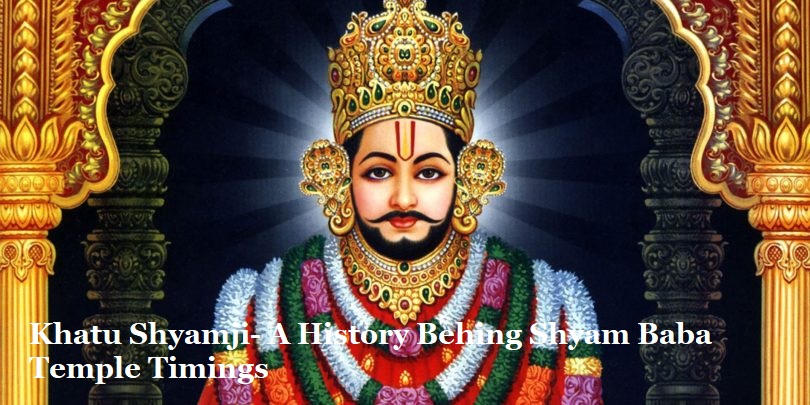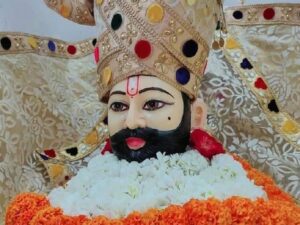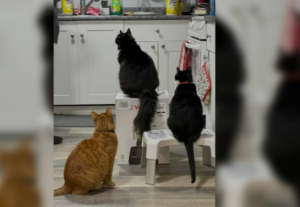Khatu Shyamji- A History Behind Shyam Baba Temple Timings

With unwavering confidence in your heart, you must travel to Khatu Shyamji, a village of religious significance in Rajasthan’s Sikar District that is located about 80 kilometres from Jaipur. Even today, pilgrims travel great distances while carrying saffron flags and singing praising songs to the god. After all, Shyam Baba resides there, and he is reputed to grant any wishes you confide in him.
Also Read: –Bhoomi pujan of Ram Temple in Ayodhya: List of persons who will attend historic ceremony on August 5
Khatu Shyamji is worshipped in the same form as Lord Krishna since the two are interchangeable. In Hinduism, Barbarika, the son of Ghatotkacha, is represented by KhatuShyam. The Mahabharata is where the legend starts. The courageous prince Bhima, the second of the Pandava brothers, was the great-grandfather of Barbarika, also known as Khatu Shyamji or Shyam Baba. He was the progeny of Bhima through Jagadamba, one of Bhima’s wives, and Ghatotkacha. Barbarika showed incredible bravery as a fighter even as a young child. His mother taught him the fundamentals of combat. Shiva, pleased with his abilities, gave him three arrows that could never fail. Later, the god of fire Agni gave him the bow that would enable him to triumph across the three realms.
Barbarika was eager to engage in combat after learning of the fierce conflict between the Pandavas and the Kauravas. He made a commitment to his mother that he would support the losing team. He then mounted his Blue Horse while carrying his three arrows and bow after touching Jagadamba’s feet.

Barbarika was halted by Lord Krishna, who was appearing as a Brahmin, to assess his power. He even made an attempt to mock him by suggesting that he would only have three arrows for the crucial combat. Barbarika said that he could defeat all of his foes with one arrow. He said he marked everything he intended to destroy with the first arrow. He could mark everything he wanted to save if he used the second arrow. The third arrow would then be released, destroying all that was indicated. He was given the task by Lord Krishna to bind every leaf on the peepal tree in front of him. After agreeing to the challenge, Barbarika began to close his eyes and meditate in order to discharge his arrow. Then Krishna took a leaf off the tree and placed it beneath Barbarika’s foot without her knowing.
When Barbarika shot his first arrow, it initially marked every leaf on the tree before settling on Krishna’s leg. Krishna asked Barbarika, perplexed, why the arrow was circling around his foot. According to Barbarika, the arrow must have been aiming at a leaf that was under his foot. If Krishna didn’t want to get wounded, Barbarika advised him to get away. As soon as Krishna lifted his foot, he was surprised to see that the first arrow had also left a mark on the leaf he had hid. Of course, when the third arrow was finally fired, it gathered all the leaves and knotted them together, including the one that was hidden under Krishna’s foot. Krishna came to the conclusion that the arrows were blessed and faultless. He enquired as to who the boy would support in the conflict. Barbarika declared that he would support the weaker side. At that time, Lord Krishna was aware that the Kauravas would eventually lose. The young man then offered to help Krishna, and Barbarika made him a promise to give him anything he wanted.
Right away, Lord Krishna demanded that he surrender his head. Barbarika was in disbelief. He asked the Brahmin to reveal who he really was. Then, Lord Krishna manifested his divine form to Barbarika in a vision. Barbarika was informed by him that the bravest Kshatriya’s head had to be sacrificed prior to the combat. He also thought Barbarika to be the bravest of the Kshatriya warriors, which is why he had requested Barbarika’s head as a gesture of goodwill.

Barbarika offered his head as a sacrifice to Krishna in accordance with the Lord’s instructions. But he also received a blessing from Krishna promising that he would go by the name Shyam, one of Krishna’s many monikers, during the Kaliyuga era. Along with giving him the gift, Krishna also proclaimed that everyone who utters his name with sincerity will be blessed and have all of their wishes come true.
On the twelfth day of the Shukla Paksha in the month of Phalgun, Barbarika made her sacrifice. The young man asked to see the combat through to the end even though he was laying down his skull, and his request was granted. The head was positioned on a hill with a view of the battleground. After the battle, the Pandava brothers who had prevailed quarrelled about who should take credit for the victory. At this point, Lord Krishna advised that since Barbarika’s head had witnessed the entire conflict, he should be permitted to render an opinion. Barbarika’s head asserted that Lord Krishna was in charge of the triumph since his counsel, assistance, and game plan had been essential.
The head is thought to have been taken from the holy pond close to the current Khatu Shyamji shrine some time after the Battle of Kurukshetra. A dip in this pond heals all ills and brings about excellent health. As a result, during the fair that takes place in the month of Phalgun, pilgrims from all around throng the pond and take a swim to atone for their sins committed in this life.
History of Khatu Shyam Baba Temple, Barbarik temple
Khatu Shyam Baba took on the identity of “Barbarik ” during the Mahabharata, the grandson of Maharaja Bhima and Ghatovacchak. Since he was a young boy, Barbarik has been a fierce and formidable warrior. Agni Dev provided him a special bow, and Lord Shiva bestowed three arrows onto him as a blessing after spotting Barbarik’s similar force skill. This benefit led to the emergence of the term “three arrows” for barbarians. After seeing the bloody battle of the Mahabharata, Barbaric declared his desire to experience combat firsthand. He gave his mother permission to go to combat and pulled out all three of his arrows to participate in the battle.
Lord Shri Krishna advised the barbarians to take their tests because no one could win the battle with only three arrows when they were about to engage in combat. The first arrow will designate the established spots, and the second and third arrows can securely secure and demolish those areas, according to Barberik, who went on to explain the meaning of the three arrows.
Both the Kauravas and the Pandavas desired to maintain them in their favour because of the blessing they had received from Barbarik. Then, while taking the shape of a Brahmin, Lord Krishna demanded his head, which he later gave to Barbarik. Barbaric urged them to come to him in their true form because of this bizarre demand. As the most valiant and Kshatriya fighter in the battle, Shri Krishna then manifested and informed Barbarik that his sacrifice was crucial to the success of the battle. Barbriak cut off his head and handed it to Shri Krishna as a gift after hearing his such pledge. When Lord Shri Krishna discovered his remarkable gift, he granted him the blessing that he would henceforth be known as “Shyam” in Lord Shri Krishna’s name across the entire world.
Importance of Khatu Shyam Temple
At the conclusion of the battle, Lord Krishna offered the barbarian’s head to the Roopvati river. After the king of Khatu village had a dream about the wonders surrounding the Shyam Kund in Kaliyug, Khatu Shyam Mandir was built in Phalgun month. In that temple, the Khatu Baba was placed on the eleventh day of Shukla Masat. Deewan Abhayasinh rebuild this temple in 1720 AD, and ever since, the aura of the temple still lingers. Shyam Kund is well-known both domestically and overseas. It is said that those who take a shower in this pool will have all of their wishes granted. In all of Baba’s temples, this one has received the most recognition.
Khatu Temple Opening Hours:
| Summer: | Winter: |
| 4:30 AM in the Morning. 12.30 pm P.M. | 5:30 AM in the Morning. From 1:00 p.m. |
| Evening 5:00 P.M. From 10:00 p.m. | Evening 4:00 P.M. From 9:00 p.m. |
Khatu Temple Aarti Time:
| Aarti | Summer | Winter |
| Mangala Aarti | 4:30 am | 5.30 am |
| Shrngar Aarti | 08:00 am | 07:00 am |
| Raj-Bhogh Aarti | 12:00 pm | 12:30 pm |
| Evening Aarti | 8:30 pm | 07:00 pm |
| Sleeping Aarti | 10:00 pm | 09:00 pm |

Om Shri Shyam Devay Namaha”
Khatu Shyam Aarti
ओम जय श्री श्याम हरे, बाबा जय श्री श्याम हरे
खाटू धाम बिराजत, अनुपम रूप धरे ओम जय श्री श्याम हरे …
रत्न जादीत सिंहासन, सिर पर चन्वर धुले
तन केहरिया बागो, कुंडल श्रवण पपडे, ओम जय श्री श्याम हरे …
गल पुशपोन की माला, सर पर मुकुट धरे
खेवत धूप, अग्नि पर दीपक ज्योति जले, ओम जय श्री श्याम हरे …
मोदक, खीर, चुरमा सुवर्ण थाल भरे
सेवक भोग लगावत, सेवा नित्य कर, ओम जय श्री श्याम हरे …
झांज, कोटेरा और चावल, शंख मरिदंग करे
भक्त आरती गावे, जय जयकार करे ओम जय श्री श्याम हरे …
जो ध्याव फल पावे, सब दुख से उबरे,
सेवक जन निज मुखसे, श्री श्याम श्याम उचरे, ओम जय श्री श्याम हरे …
श्री श्याम बिहारीजी की आरती, जो कोई नर गाव
कहत सुधीर अग्यानी , मनवंचित फाल पावे, ओम जय श्री श्याम हरे …










